Design, Synthesis, Crystal Structure, In Vitro and In Silico Evaluation of New N′-Benzylidene-4-tert-butylbenzohydrazide Derivatives as Potent Urease Inhibitors
Abstract
1. Introduction
2. Result and Discussion
2.1. Chemistry
2.2. Crystal Structure Description
2.2.1. Crystal Structure of 4-(tBu)-N′-(2-Hydroxy-3-methoxybenzylidene)benzohydrazide (5)
2.2.2. Crystal Structure of 4-Tert-butyl-N′-{(E)-[4-(dimethylamino)phenyl]methylidene}benzohydrazide (14)
2.3. In Vitro Urease Inhibitory Activity
2.4. Structure-Activity Relationship (SAR)
2.5. Molecular Docking, Interactions Report
3. Experimental
3.1. Materials and Methods
3.1.1. General Procedure for the Synthesis of Methyl-4-(t-Bu)benzoate (2) and 4-(Tert-butyl) benzohydrazide (3)
3.1.2. General Procedure for the Synthesis of N-Acylhydrazones 4-(t-But)benzohydrazide (4–26)
3.2. Urease Inhibition Assay
3.3. Docking Methodology
3.4. Crystal Structure Determination
3.5. Analytical Physical and Spectroscopic Data of the Synthesized Compounds
3.5.1. 4-(Tert-butyl)-N′-(4-fluoro-3-methoxybenzylidene)benzohydrazide (4)
3.5.2. 4-(t-But)-N′-(2-Hydroxy-3-methoxybenzylidene)benzohydrazide (5)
3.5.3. N′-(Anthracen-9-ylmethylene)-4-(tert-butyl)benzohydrazide (6)
3.5.4. N′-(5-Bromo-2-methoxybenzylidene)-4-(t-But)benzohydrazide (7)
3.5.5. N′-(3,4-Dihydroxybenzylidene)-4-tert-butylbenzohydrazide (8)
3.5.6. N′-(2,3,4-Trimethoxybenzylidene)-4-tert-butylbenzohydrazide (9)
3.5.7. 4-(Tert-butyl)-N′-(2-chloro-5-nitrobenzylidene)benzohydrazide (10)
3.5.8. 4-(Tert-butyl)-N′-(4-ethoxy-2-methoxybenzylidene)benzohydrazide (11)
3.5.9. 4-(Tert-butyl)-N′-(3-hydroxybenzylidene)benzohydrazide (12)
3.5.10. 4-(Tert-butyl)-N′-(3,4,5-trimethoxybenzylidene)benzohydrazide (13)
3.5.11. 4-(Tert-butyl)-N′-(4-(dimethylamino)benzylidene)benzohydrazide (14)
3.5.12. 4-(Tert-butyl)-N′-(2,4-dichlorobenzylidene)benzohydrazide (15)
3.5.13. 4-(Tert-butyl)-N′-(3,5-di-tert-butyl-4-hydroxybenzylidene)benzohydrazide (16)
3.5.14. N′-(3,5-Dichloro-2-hydroxybenzylidene)-4-tert-butylbenzohydrazide (17)
3.5.15. N′-(4-Nitrobenzylidene)-4-tert-butylbenzohydrazide (18)
3.5.16. 4-(Tert-butyl)-N′-(2,6-dimethoxybenzylidene)benzohydrazide (19)
3.5.17. 4-(t-But)-N′-(4-Hydroxybenzylidene)benzohydrazide (20)
3.5.18. N′-(2,4,6-Trimethoxybenzylidene)-4-tert-butylbenzohydrazide (21)
3.5.19. 4-(Tert-butyl))-N′-(2,4-dichloro-3-hydroxybenzylidene)benzohydrazide (22)
3.5.20. 4-(Tert-butyl))-N′-(3-methoxy-4-hydroxybenzylidene)benzohydrazide (23)
3.5.21. 4-(t-But)-N′-(2-Hydroxybenzylidene)benzohydrazide (24)
3.5.22. 4-(t-But)-N′-(3,4-Dimethoxybenzylidene)benzohydrazide (25)
3.5.23. 4-(t-But)-N′-(3,5-Di-tert-butyl-2-hydroxybenzylidene)benzohydrazide (26)
4. Conclusions
Author Contributions
Funding
Institutional Review Board Statement
Informed Consent Statement
Data Availability Statement
Acknowledgments
Conflicts of Interest
Sample Availability
References
- Ahmed, M.; Qadir, M.A.; Hameed, A.; Arshad, M.N.; Asiri, A.M.; Muddassar, M. Azomethines, isoxazole, N-substituted pyrazoles and pyrimidine containing curcumin derivatives: Urease inhibition and molecular modeling studies. Biochem. Biophys. Res. Commun. 2017, 490, 434–440. [Google Scholar] [CrossRef] [PubMed]
- Sudkolai, S.T.; Nourbakhsh, F. Urease activity as an index for assessing the maturity of cow manure and wheat residue vermicomposts. Waste Manag. 2017, 64, 63–66. [Google Scholar] [CrossRef] [PubMed]
- Taha, M.; Shah, S.A.A.; Khan, A.; Arshad, F.; Ismail, N.H.; Afifi, M.; Imran, S.; Choudhary, M.I. Synthesis of 3,4,5-trihydroxybenzohydrazone and evaluation of their urease inhibition potential. Arab. J. Chem. 2019, 12, 2973–2982. [Google Scholar] [CrossRef]
- Peek, R.M.; Blaser, M.J. Helicobacter pylori and gastrointestinal tract adenocarcinomas. Nat. Cancer 2002, 2, 28–37. [Google Scholar] [CrossRef] [PubMed]
- Upadhyay, V.; Poroyko, V.; Kim, T.-J.; Devkota, S.; Fu, S.; Liu, D.; Tumanov, A.V.; Koroleva, E.P.; Deng, L.; Nagler, C.; et al. Lymphotoxin regulates commensal responses to enable diet-induced obesity. Nat. Immunol. 2012, 13, 947–953. [Google Scholar] [CrossRef]
- Shamim, S.; Khan, K.M.; Salar, U.; Ali, F.; Lodhi, M.A.; Taha, M.; Khan, F.A.; Ashraf, S.; Ul-Haq, Z.; Ali, M.; et al. 5-Acetyl-6-methyl-4-aryl-3,4-dihydropyrimidin-2(1 H )-ones: As potent urease inhibitors; synthesis, in vitro screening, and molecular modeling study. Bioorganic Chem. 2017, 76, 37–52. [Google Scholar] [CrossRef]
- Judge, V.; Narasimhan, B.; Ahuja, M.; Sriram, D.; Yogeeswari, P.; De Clercq, E.; Pannecouque, C.; Balzarini, J. Isonicotinic acid hydrazide derivatives: Synthesis, antimicrobial activity, and QSAR studies. Med. Chem. Res. 2011, 21, 1451–1470. [Google Scholar] [CrossRef]
- Taha, M.; Ismail, N.H.; Lalani, S.; Fatmi, M.Q.; Wahab, A.T.; Siddiqui, S.; Khan, K.M.; Imran, S.; Choudhary, M.I. Synthesis of novel inhibitors of α-glucosidase based on the benzothiazole skeleton containing benzohydrazide moiety and their molecular docking studies. Eur. J. Med. Chem. 2015, 92, 387–400. [Google Scholar] [CrossRef]
- Taha, M.; Ismail, N.H.; Jamil, W.; Rashwan, H.; Kashif, S.M.; Sain, A.A.; Adenan, M.I.; Anouar, E.H.; Ali, M.; Rahim, F.; et al. Synthesis of novel derivatives of 4-methylbenzimidazole and evaluation of their biological activities. Eur. J. Med. Chem. 2014, 84, 731–738. [Google Scholar] [CrossRef]
- Liu, L.; Alam, M.S.; Lee, D.-U. Synthesis, Antioxidant Activity and Fluorescence Properties of Novel Europium Complexes with (E)-2- or 4-hydroxy-N’-[(2-hydroxynaphthalen-1-yl)methylene]benzohydrazide Schiff Base. Bull. Korean Chem. Soc. 2012, 33, 3361–3367. [Google Scholar] [CrossRef]
- Prachumrat, P.; Kobkeatthawin, T.; Ruanwas, P.; Boonnak, N.; Laphookhieo, S.; Kassim, M.B.; Chantrapromma, S. Synthesis, Crystal Structure, Antioxidant, and α-Glucosidase Inhibitory Activities of Methoxy-substituted Benzohydrazide Derivatives. Crystallogr. Rep. 2018, 63, 405–411. [Google Scholar] [CrossRef]
- Zhen-Gao, S.; Fang, L.; Jian-Wei, Z.; Jin-Long, S.; Ying, G.; Ning, Z.; Yun-Peng, D. Synthesis, Crystal structure and antioxidant of 3, 5-dihydroxy-N′-(5-bro-2-hydroxybenzylidene) benzohydrazide hydrate. Struct. Chem. 2012, 31, 1309–1314. [Google Scholar]
- Rando, D.G.; Avery, M.A.; Tekwani, B.L.; Khan, S.I.; Ferreira, E.I. Antileishmanial activity screening of 5-nitro-2-heterocyclic benzylidene hydrazides. Bioorganic Med. Chem. 2008, 16, 6724–6731. [Google Scholar] [CrossRef] [PubMed]
- Yele, V.; Mohammed, A.A.; Wadhwani, A.D. Synthesis and Evaluation of Aryl/Heteroaryl Benzohydrazide and Phenylacetamide Derivatives as Broad-Spectrum Antibacterial Agents. ChemistrySelect 2020, 5, 10581–10587. [Google Scholar] [CrossRef]
- Reino, J.L.; Saiz-Urra, L.; Hernández-Galán, R.; Arán, V.J.; Hitchcock, P.B.; Hanson, J.R.; Gonzalez, M.P.; Collado, I.G. Quantitative Structure−Antifungal Activity Relationships of Some Benzohydrazides against Botrytis cinerea. J. Agric. Food Chem. 2007, 55, 5171–5179. [Google Scholar] [CrossRef]
- Wayua, C.; Roy, J.; Putt, K.S.; Low, P.S. Selective Tumor Targeting of Desacetyl Vinblastine Hydrazide and Tubulysin B via Conjugation to a Cholecystokinin 2 Receptor (CCK2R) Ligand. Mol. Pharm. 2015, 12, 2477–2483. [Google Scholar] [CrossRef]
- Madhira, S.; Mandava, K.; Manda, S.; Prasanna, S.; Vijayalaxmi, T. Synthesis and Evaluation of Some Novel N, N-Dialkylaminoalkoxy-2-Oxo-Indole-3-Ylidene Benzohydrazides as Anticonvulsant Agents. IOSR J. Pharm. Biol. Sci. 2017, 12, 84–93. [Google Scholar] [CrossRef]
- Mukhtar, S.S.; Hassan, A.S.; Morsy, N.M.; Hafez, T.S.; Hassaneen, H.M.; Saleh, F.M. Overview on Synthesis, Reactions, Applications, and Biological Activities of Schiff Bases. Egypt. J. Chem. 2021. [Google Scholar] [CrossRef]
- Shanthalakshmi, K.; Mahesh, B.; Belagali, S. Synthesis of Benzothiazole Schiff’s Bases and screening for the Antioxidant Activity. J. Chem. Pharm. Res. 2016, 8, 240–243. [Google Scholar]
- Tariq, S.; Kamboj, P.; Amir, M. Therapeutic advancement of benzothiazole derivatives in the last decennial period. Arch. der Pharm. 2018, 352, e1800170. [Google Scholar] [CrossRef]
- Shah, S.; Khan, M.; Ali, M.; Wadood, A.; Rehman, A.U.; Shah, Z.; Yousaf, M.; Salar, U.; Khan, K.M. Bis-1,3,4-Oxadiazole Derivatives as Novel and Potential Urease Inhibitors; Synthesis, In Vitro, and In Silico Studies. Med. Chem. 2022. [Google Scholar] [CrossRef]
- Ikram, M.; Khan, M.; Ahmad, S.; Rehman, S.; Schulzke, C. The crystal structure of 4-tert-butyl-N′-[(E)-(4-fluoro-3-methoxyphenyl)methylidene]benzohydrazide, C19H21F1N2O2. Z. Kristallogr. NCS 2018, 233, 643–645. [Google Scholar] [CrossRef]
- Zhang, Y.; Zhang, S.-P.; Wu, Y.-Y.; Shao, S.-C. 4-Fluorobenzaldehyde salicylhydrazone. Acta Crystallogr. Sect. E Struct. Rep. Online 2005, 62, o119–o120. [Google Scholar] [CrossRef]
- Dutkiewicz, G.; Narayana, B.; Samshuddin, S.; Yathirajan, H.S.; Kubicki, M. Synthesis and Crystal Structures of Two New Schiff Base Hydrazones Derived from Biphenyl-4-Carbohydrazide. J. Chem. Crystallogr. 2011, 41, 1442–1446. [Google Scholar] [CrossRef][Green Version]
- Maheswari, R.; Manjula, J.; Gunasekaran, B.; Bakiyaraj, G. (E)-4-Methoxy-N′-(2,4,5-trifluorobenzylidene)benzohydrazide monohydrate. IUCrData 2016, 1, x160846. [Google Scholar] [CrossRef]
- Cui, Y.-M.; Yang, D.; Guo, W.; Wang, Q.; Zhang, P. Substituent group effects on the self-assembly of oxovanadium(V) complexes with hydrazone ligands bearing benzoic acid (1-methyl-3-oxobutylidene)hydrazide backbones. J. Struct. Chem. 2016, 57, 840–844. [Google Scholar] [CrossRef]
- Narayana, B.; Sunil, K.; Yathirajan, H.S.; Sarojini, B.K.; Bolte, M. 2-Bromo-N′-[(E)-(4-fluorophenyl)methylene]-5-methoxybenzohydrazide monohydrate. Acta Crystallogr. Sect. E Struct. Rep. Online 2007, 63, o2948. [Google Scholar] [CrossRef]
- Wardell, S.M.S.V.; Ferreira, M.D.L.; De Souza, M.V.N.; Wardell, J.L.; Low, J.N.; Glidewell, C. 2,4-Difluorobenzaldehyde benzoylhydrazone and 2,4-dichlorobenzaldehyde benzoylhydrazone are isostructural at 120 K withZ′ = 2: Complex sheets built from N—H...O, C—H...O and C—H...π(arene) hydrogen bonds. Acta Crystallogr. Sect. C Cryst. Struct. Commun. 2006, 62, o118–o121. [Google Scholar] [CrossRef]
- Seifullina, I.I.; Martsinko, E.E.; Chebanenko, E.A.; D’Yakonenko, V.V.; Shishkina, S.V.; Pirozhok, O.V. Structure of the {[Cu2Ge(μ-Cit)2(μ-INH)2]·4H2O} n Coordination Polymer Where H4Cit is Citric Acid, INH is Isonicotinic Acid Hydrazide. J. Struct. Chem. 2018, 59, 154–159. [Google Scholar] [CrossRef]
- He, D.-H.; Zhu, Y.-C.; Yang, Z.-R. N′-(4-Fluorobenzylidene)-3,4,5-trimethoxybenzohydrazide. Acta Crystallogr. Sect. E Struct. Rep. Online 2008, 64, o1648. [Google Scholar] [CrossRef]
- Maheswari, R.; Manjula, J.; Gunasekaran, B. (E)-4-Chloro- N′ -(2,4,5-trifluorobenzylidene)benzohydrazide. IUCrData 2016, 1. [Google Scholar] [CrossRef]
- Liu, M.; Duan, Y.; Wang, Y.; Zhang, W.-X.; Liu, S. (E)-2-[2-(4-Fluorobenzylidene)hydrazinocarbonyl]-N-isopropylbenzamide. Acta Crystallogr. Sect. E Struct. Rep. Online 2009, 65, o1599. [Google Scholar] [CrossRef] [PubMed]
- Mao, W.-J.; Lv, P.-C.; Shi, L.; Li, H.-Q.; Zhu, H.-L. Synthesis, molecular docking and biological evaluation of metronidazole derivatives as potent Helicobacter pylori urease inhibitors. Bioorganic Med. Chem. 2009, 17, 7531–7536. [Google Scholar] [CrossRef] [PubMed]
- CCG, Molecular Operating Environment (MOE); Chem Comput Gr Inc.: Montreal, QC, Canada, 2022; Available online: https://www.chemcomp.com/ (accessed on 4 August 2022).
- Sheldrick, G.M. Crystal structure refinement with SHELXL. Acta Crystallogr. Sect. C Struct. Chem. 2015, C71, 3–8. [Google Scholar] [CrossRef] [PubMed]
- Farrugia, L.J. WinGX and ORTEP for Windows: An update. J. Appl. Crystallogr. 2012, 45, 849–854. [Google Scholar] [CrossRef]
- Sheldrick, G.M. SHELXT—Integrated space-group and crystal-structure determination. Acta Crystallogr. Sect. A Found. Adv. 2015, 71, 3–8. [Google Scholar] [CrossRef]

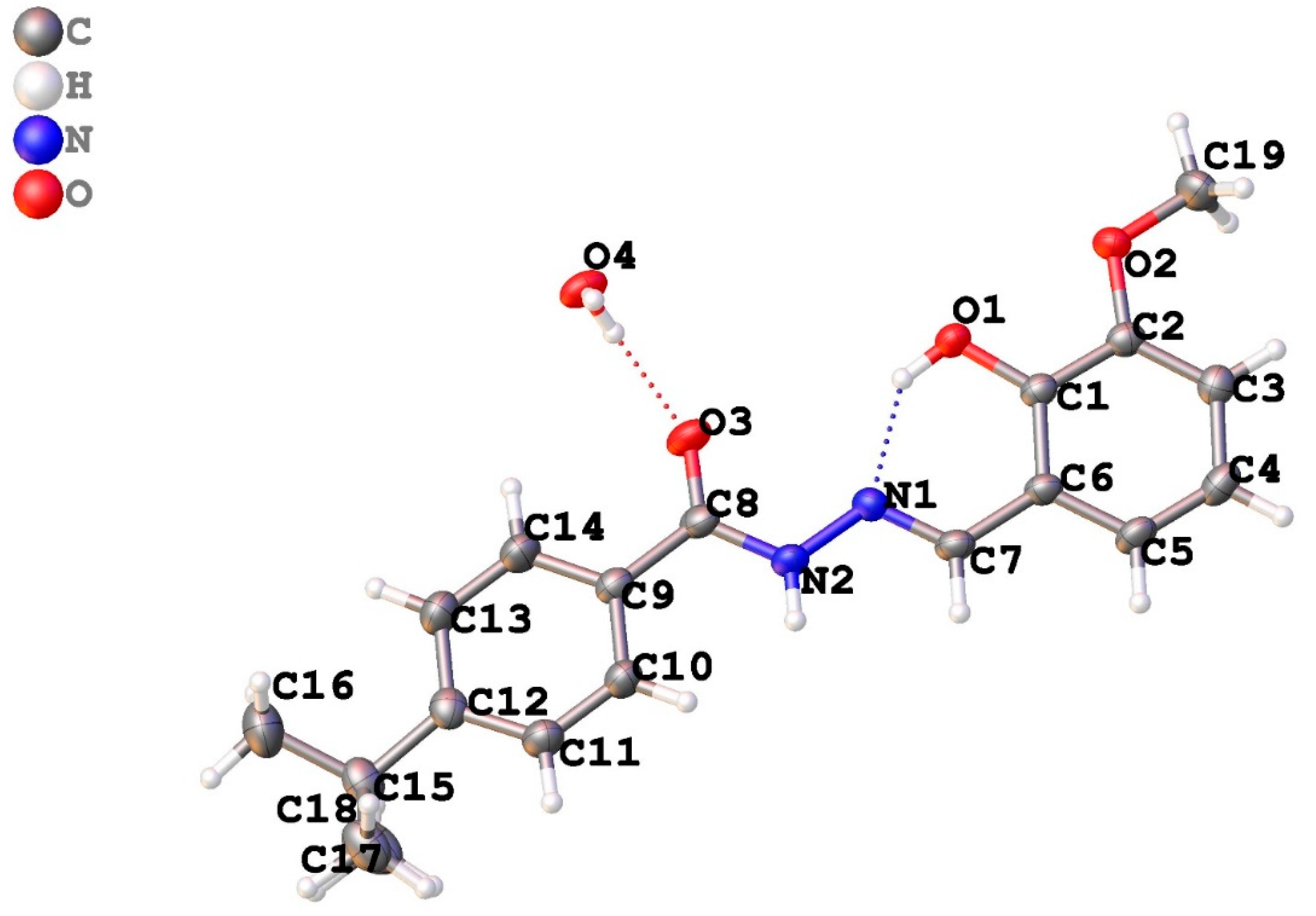

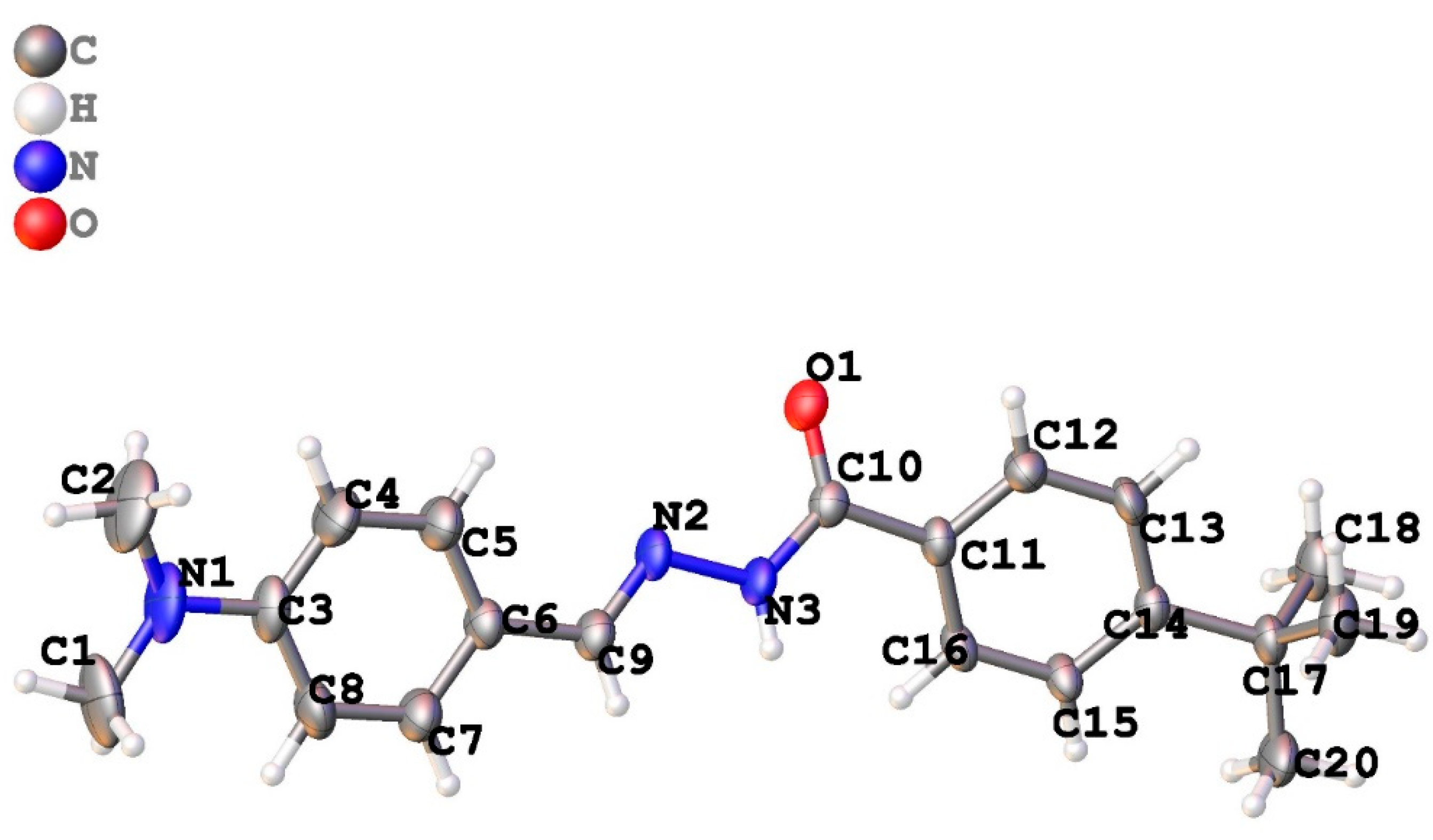

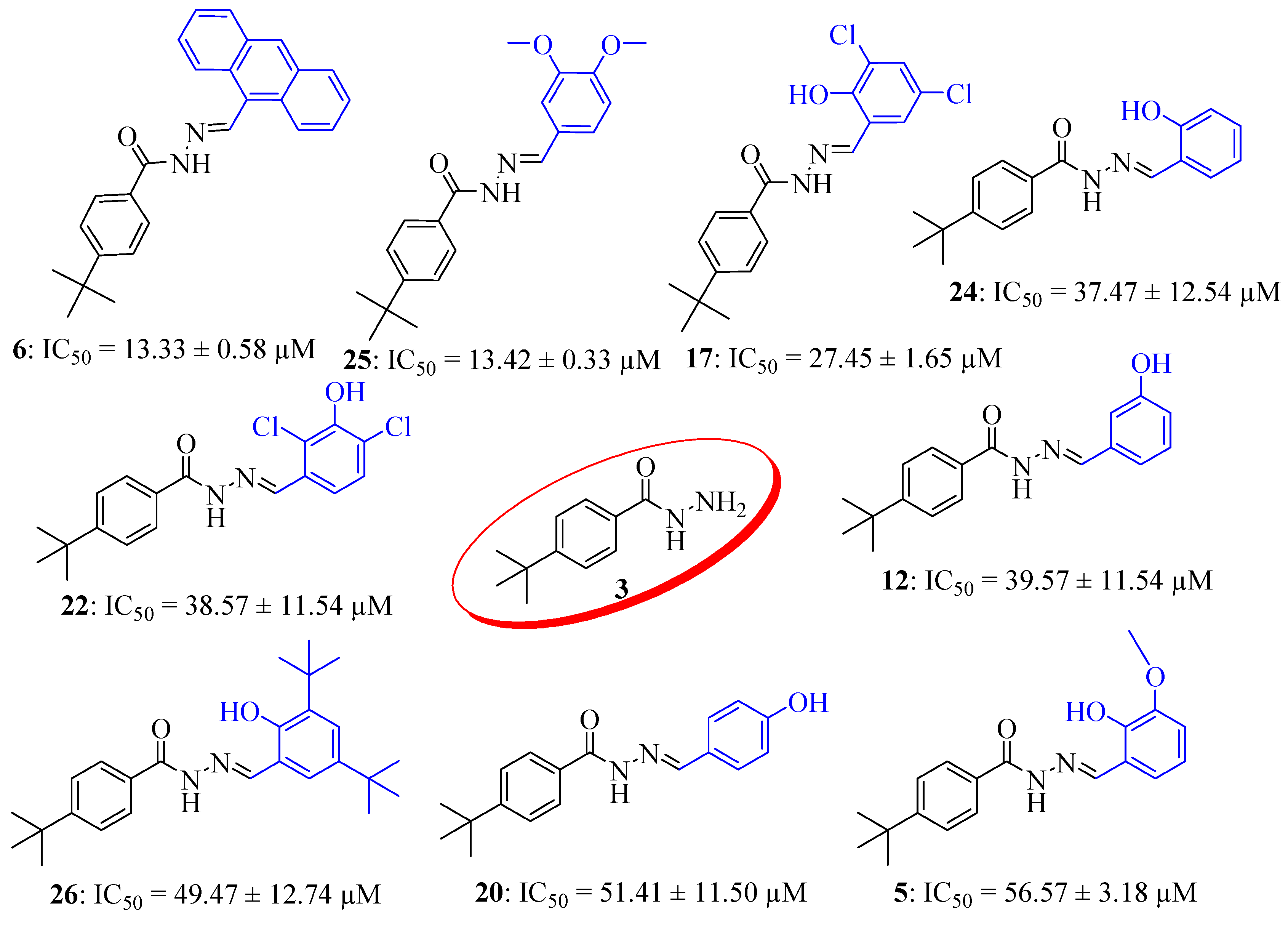
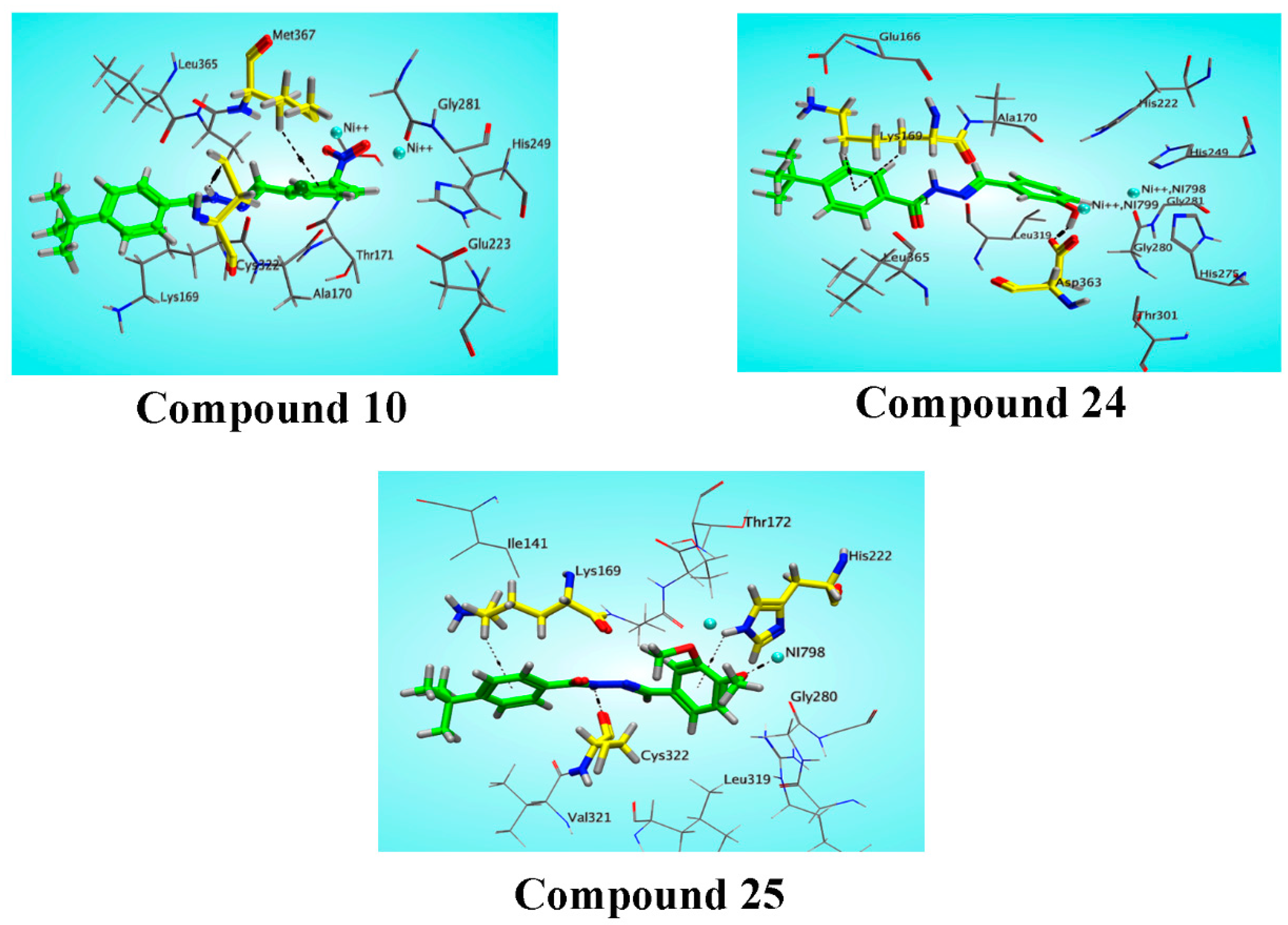
| Compds. | Ar | Compds. | Ar | Compds. | Ar |
|---|---|---|---|---|---|
| 4 |  | 12 |  | 20 |  |
| 5 |  | 13 | 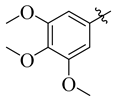 | 21 | 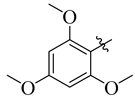 |
| 6 |  | 14 |  | 22 |  |
| 7 |  | 15 |  | 23 |  |
| 8 | 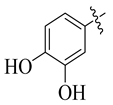 | 16 |  | 24 |  |
| 9 |  | 17 |  | 25 |  |
| 10 |  | 18 |  | 26 | 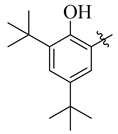 |
| 11 |  | 19 |  | - | - |
| Complex | 5 | 14 |
|---|---|---|
| Empirical formula | C19H24N2O4 | C20H25N3O |
| Formula mass | 344.40 | 323.43 |
| Temperature (K) | 170 K | 170 K |
| Wavelength (Å) | 0.71073 | 0.71073 |
| Crystal system, space group | Monoclinic, Cc | Monoclinic, P21/n |
| Unit cell dimensions (Å) | a = 7.1944 (14) Å, b = 41.282 (8) Å, c = 6.4595 (13) Å, β = 104.83 (3)° | a = 12.408 (3) Å, b = 8.5968 (17) Å, c = 35.223 (7) Å |
| Z, Volume (Å3) | 1854.6 (7) | 3757.2 (14) |
| Crystal size (mm) | 0.48 × 0.47 × 0.10 | 0.48 × 0.17 × 0.12 |
| Calculated density (Mg m−3) | 1.233 | 1.144 |
| Absorption coefficient (mm−1 ) | 0.09 | 0.07 |
| F(000) | 736 | 1392 |
| Θ range for data collection | 6.5–58.9° | 6.2–59.1° |
| Limiting indices | h = −9→9, k = −56→47, l = −8→8 | h = −13→13, k = −9→9, l = −38→38 |
| Measured reflections | 10166 | 20065 |
| Independent reflections | 4887 | 2509 |
| Reflections with I > 2σ(I) | 3476 | 1888 |
| Rint | 0.105 | 0.247 |
| Refinement method | Full-matrix least-squares on F2 | Full-matrix least-squares on F2 |
| Data/restraints/ parameters | 4887/246/3 | 2509/0/230 |
| R[F2 > 2σ(F2)] | 0.072 | 0.079 |
| Moiety | Bond Length, Å | Moiety | Bond Length, Å |
| O1—C1 | 1.356 (4) | N1—C7 | 1.284 (5) |
| O2—C2 | 1.368 (4) | N1—N2 | 1.364 (4) |
| O2—C19 | 1.413 (5) | N2—C8 | 1.349 (5) |
| O3—C8 | 1.230 (5) | C8—C9 | 1.492 (6) |
| C6—C7 | 1.451 (5) | C12—C15 | 1.528 (6) |
| Moiety | Bond Angle, ° | Moiety | Bond Angle, ° |
| C2—O2—C19 | 116.6 (3) | N1—C7—C6 | 119.9 (3) |
| C7—N1—N2 | 117.0 (3) | O3—C8—N2 | 121.6 (4) |
| C8—N2—N1 | 118.4 (3) | O3—C8—C9 | 122.1 (4) |
| O1—C1—C6 | 123.1 (3) | N2—C8—C9 | 116.3 (3) |
| O1—C1—C2 | 117.4 (3) | C14—C9—C10 | 117.4 (4) |
| O2—C2—C3 | 125.2 (4) | C14—C9—C10 | 117.4 (4) |
| O2—C2—C1 | 114.1 (3) | C1—C6—C7 | 121.2 (3) |
| D—H···A | d(D—H) | d(H···A) | d(D···A) | ∠(D—H···A) |
|---|---|---|---|---|
| O1—H1O···N1 | 0.87 (6) | 1.84 (6) | 2.581 (4) | 142 (6) |
| N2—H2N···O4 i | 0.85 (7) | 2.00 (7) | 2.808 (4) | 160 (6) |
| C7—H7···O4 i | 0.95 | 2.47 | 3.250 (5) | 139 |
| C19—H19A···O2 ii | 0.98 | 2.57 | 3.259 (6) | 127 |
| O4—H4O···O3 | 0.81 (5) | 1.89 (5) | 2.696 (4) | 174 (6) |
| O4—H4P···O1 iii | 0.84 (5) | 2.19 (6) | 2.967 (4) | 154 (6) |
| O4—H4P···O2 iii | 0.84 (5) | 2.42 (6) | 3.025 (4) | 130 (6) |
| Moiety | Bond Length, Å | Moiety | Bond Length, Å |
| N1—C3 | 1.386 (4) | N2—N3 | 1.395 (3) |
| N1—C2 | 1.434 (5) | N3—C10 | 1.332 (4) |
| N1—C1 | 1.437 (6) | N3—H1N3 | 0.83 (3) |
| N2—C9 | 1.260 (4) | O1—C10 | 1.237 (3) |
| Moiety | Bond Angle, ° | Moiety | Bond Angle, ° |
| C3—N1—C2 | 119.2 (4) | N1—C3—C4 | 121.9 (3) |
| C3—N1—C1 | 119.9 (3) | C8—C3—N1 | 120.4 (3) |
| C2—N1—C1 | 118.3 (3) | N2—C9—C6 | 122.9 (3) |
| C9—N2—N3 | 114.4 (2) | N2—C9—H9 | 123.3 (19) |
| C10—N3—N2 | 120.7 (2) | O1—C10—N3 | 122.9 (2) |
| C10—N3—H1N3 | 127 (2) | O1—C10—C11 | 120.7 (2) |
| N2—N3—H1N3 | 113 (2) | N3—C10—C11 | 116.4 (2) |
| N1—C1—H1A | 109.5 | N1—C1—H1B | 109.5 |
| D—H···A | d(D—H) | d(H···A) | d(D···A) | ∠(D—H···A) |
|---|---|---|---|---|
| N3—H1N3···O1 i | 0.83 (3) | 2.12 (3) | 2.939 (3) | 169 (3) |
| C9—H9···O1 i | 0.90 (3) | 2.57 (3) | 3.322 (4) | 142 (2) |
| Compounds | IC50 ± SEM (µM) | Compounds | IC50 ± SEM (µM) |
|---|---|---|---|
| 4 | 88.75 ± 7.71 | 16 | 79.01 ± 7.53 |
| 5 | 56.57 ± 3.18 | 17 | 27.45 ± 1.65 |
| 6 | 13.33 ± 0.58 | 18 | 66.14 ± 1.79 |
| 7 | 64.50 ± 3.97 | 19 | 67.48 ± 4.16 |
| 8 | 80.01 ± 7.43 | 20 | 51.41 ± 11.50 |
| 9 | 63.50 ± 3.97 | 21 | 71.27 ± 2.47 |
| 10 | 63.54 ± 3.97 | 22 | 38.57 ± 11.54 |
| 11 | 63.52 ± 2.97 | 23 | 251.74 ± 6.82 |
| 12 | 39.57 ± 11.54 | 24 | 37.47 ± 12.54 |
| 13 | 80.93 ± 7.43 | 25 | 13.42 ± 0.33 |
| 14 | 81.21 ± 7.4 | 26 | 49.47 ± 12.74 |
| 15 | 82.21 ± 7.43 | Thiourea | 21.14 ± 0.42 |
| Compds. | Docking Score | Interactions Details | ||||
|---|---|---|---|---|---|---|
| Ligand | Receptor | Interaction | Distance (Å) | E (kcal/mol) | ||
| 9 | −3.05 | C23 | 5-ring-HIS324 | π-H | 3.83 | −0.8 |
| 6-ring | NZ-LYS169 | π-cation | 4.01 | −1.4 | ||
| 10 | −5.18 | N9 | SG-CYS322 | HBD | 3.13 | −3.5 |
| O24 | NI-NI798 | metal | 1.63 | −2.0 | ||
| 6-ring | CB-MET367 | π-H | 4.38 | −0.6 | ||
| 11 | −4.14 | 6-ring | CD-LYS169 | π-H | 4.32 | −0.8 |
| 16 | −4.71 | CL9 | NE2-HIS137 | HBD | 3.65 | −1.3 |
| 6-ring | CD-LYS169 | π-H | 4.14 | −0.9 | ||
| 18 | −12.09 | C3 | OD2-ASP363 | HBD | 3.30 | −1.7 |
| O23 | NI-NI798 | metal | 1.92 | −2.9 | ||
| O24 | NI-NI799 | metal | 1.89 | −2.4 | ||
| 19 | −3.03 | N8 | SG-CYS322 | HBD | 4.09 | −0.8 |
| 22 | −2.81 | CL7 | OD2-ASP363 | HBD | 2.73 | 1.2 |
| 24 | −8.65 | O7 | OD2-ASP363 | HBD | 2.45 | 0.3 |
| 6-ring | CD-LYS169 | π-H | 4.11 | −0.7 | ||
| 25 | −10.07 | N8 | O-CYS322 | HBD | 2.68 | −2.1 |
| O24 | NI-NI 798 | metal | 1.79 | −1.8 | ||
| 6-ring | CD-LYS169 | π-H | 4.23 | −0.8 | ||
| 6-ring | NE2-HIS222 | π-H | 4.18 | −0.6 | ||
Publisher’s Note: MDPI stays neutral with regard to jurisdictional claims in published maps and institutional affiliations. |
© 2022 by the authors. Licensee MDPI, Basel, Switzerland. This article is an open access article distributed under the terms and conditions of the Creative Commons Attribution (CC BY) license (https://creativecommons.org/licenses/by/4.0/).
Share and Cite
Ahmad, S.; Khan, M.; Rehman, N.U.; Ikram, M.; Rehman, S.; Ali, M.; Uddin, J.; Khan, A.; Alam, A.; Al-Harrasi, A. Design, Synthesis, Crystal Structure, In Vitro and In Silico Evaluation of New N′-Benzylidene-4-tert-butylbenzohydrazide Derivatives as Potent Urease Inhibitors. Molecules 2022, 27, 6906. https://doi.org/10.3390/molecules27206906
Ahmad S, Khan M, Rehman NU, Ikram M, Rehman S, Ali M, Uddin J, Khan A, Alam A, Al-Harrasi A. Design, Synthesis, Crystal Structure, In Vitro and In Silico Evaluation of New N′-Benzylidene-4-tert-butylbenzohydrazide Derivatives as Potent Urease Inhibitors. Molecules. 2022; 27(20):6906. https://doi.org/10.3390/molecules27206906
Chicago/Turabian StyleAhmad, Sajjad, Momin Khan, Najeeb Ur Rehman, Muhammad Ikram, Sadia Rehman, Mahboob Ali, Jalal Uddin, Ajmal Khan, Aftab Alam, and Ahmed Al-Harrasi. 2022. "Design, Synthesis, Crystal Structure, In Vitro and In Silico Evaluation of New N′-Benzylidene-4-tert-butylbenzohydrazide Derivatives as Potent Urease Inhibitors" Molecules 27, no. 20: 6906. https://doi.org/10.3390/molecules27206906
APA StyleAhmad, S., Khan, M., Rehman, N. U., Ikram, M., Rehman, S., Ali, M., Uddin, J., Khan, A., Alam, A., & Al-Harrasi, A. (2022). Design, Synthesis, Crystal Structure, In Vitro and In Silico Evaluation of New N′-Benzylidene-4-tert-butylbenzohydrazide Derivatives as Potent Urease Inhibitors. Molecules, 27(20), 6906. https://doi.org/10.3390/molecules27206906










